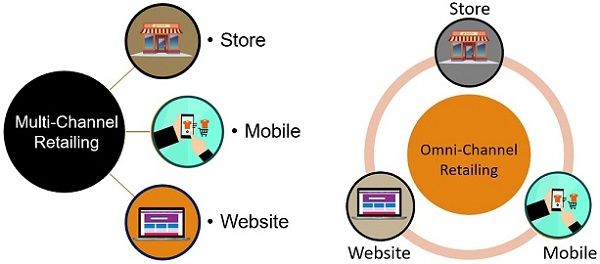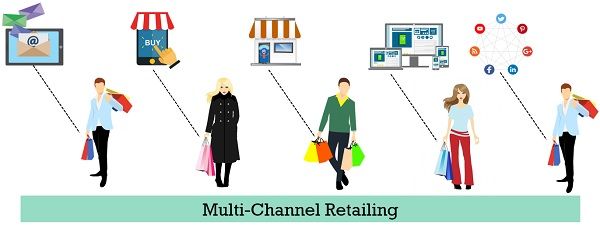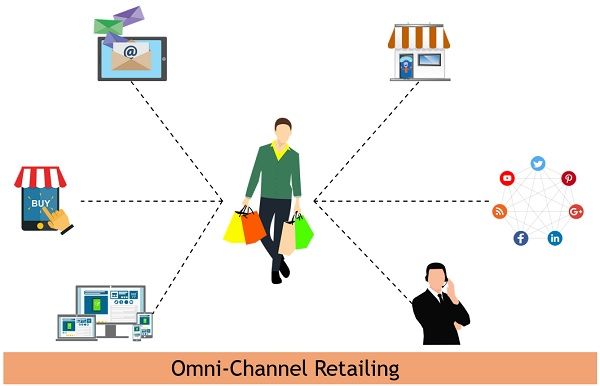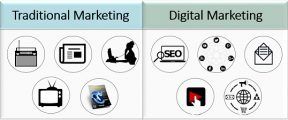 While in multichannel retailing many channels of distribution are used to focus on the product, in omnichannel retailing, different channels of distribution are used by the marketer to focus on the customer.
While in multichannel retailing many channels of distribution are used to focus on the product, in omnichannel retailing, different channels of distribution are used by the marketer to focus on the customer.
We all know that customers have multiple options today from where they can buy products, but they have lacks time and attention. In this way, various approaches to marketing are used by marketers these days. Of these approaches, the two most common ones are – Multi-Channel Retailing and Omni-Channel Retailing. Because of the presence of various interactive touchpoints to consumers, but there exists a fine line of differences between them.
In the omnichannel approach, the marketer uses all the available channels at their disposal. On the other hand, in the multichannel approach, the marketer uses multiple channels.
What is Channel?
The term ‘channel‘ refers to the touchpoint or medium with the help of which the interaction between company and customer takes place.
This post provides you with all the basic information and differences between omnichannel and multichannel retailing.
Content: Multi-Channel Vs Omni-Channel
Comparison Chart
| Basis for Comparison | Multi-Channel | Omni-Channel |
|---|---|---|
| Meaning | Multichannel Retailing is when a range of channels for selling a particular product across various platforms. | Omnichannel retailing is the use of various marketing channels, in a manner that facilitates the consumer an uninterrupted shopping experience. |
| Concept | Division between channels | Integration of all channels |
| Channel Focus | Interactive Channels only | Interactive and Mass Communication channels |
| Channel scope | Retail Channels: Store, e-commerce website and mobile. | Retail Channels: Store, Mobile, Website, Application, Social Media, Customer touch points. |
| View | Multiple views of customer for different digital channels. | A single view of the customer across all channels. |
| Focus | Maximum customer engagement | Maximum customer experience |
| Facilitates | It facilitates the marketer in connecting the dots concerning their customers. | It facilitates the marketer in connecting the dots concerning the brand. |
| Data | Not shared across channels | Shared across channels |
| Salespersons | Do not adapt selling behavior. | Adapt selling behaviour using different arguments depending on each customer's needs and knowledge of the product. |
Definition of Multi-Channel Retailing
Multi-channel Retailing refers to a business strategy that provides customers with an array of sales channels from where the customers can get through the marketer.
The channels are basically platforms, where similar products are offered to the customers. Plus, the channels may be offline brick or mortar stores or online e-commerce or shopping website. It is basically an approach to reach the customers, as per their choice of convenience. It is the use of more than one distribution channel to revolve around your product.
Multichannel marketing is tapping various channels like:
- Marketplaces (Shops, showrooms, etc)
- Social media websites (Facebook, Instagram, Twitter)
- Email campaigns
- Chats (WhatsApp or Facebook Groups)
- Shopping sites (Amazon, Flipkart, Grofers, Bigbasket, etc)
- Website
In this, the company provides different ways to purchase goods and services. It is a method of building a brand and getting through the customers. And to do so the company aims to get maximum return on the investment.
Let us dig a bit deeper, Multi-Channel Marketing:
- Takes place when a business enterprise taps various marketing channels in order to reach the same or different segments of the market.
- Aims to ensure availability in terms of time, consumer, quality, and place.
- Also used when unrelated products are sold within a single market, due to the difference in the size of buyers, variation in the geographic concentration.
In short, we could say that multi-channel retailing is one that is changed as per the characteristics of the consumers.
Also Read: Difference Between Traditional Marketing and Digital Marketing
Definition of Omni-Channel Retailing
Omnichannel is a primary nurturing and consumer engagement-based approach. As per this approach, the customers get access to the products, offers, and services on different channels, platforms, and devices. Its aim is to provide a similar experience to the customer, no matter which platform or method they select to use.
- It emphasizes combining activities within and across marketing channels, to correspond to the way consumers do shopping.
- It tends to connect all the channels seamlessly, i.e. it involves the integration of various touchpoints to serve the customer in a better fashion.
 In omni-channel retailing, marketers use various channels, so as to facilitate the customers to make purchases, right from performing research to identifying what they need, to finally selling the product
In omni-channel retailing, marketers use various channels, so as to facilitate the customers to make purchases, right from performing research to identifying what they need, to finally selling the product
Here, multiple channels are used to interact with customers and also fulfill their orders in a timely manner. The interaction between the retailer and consumer takes place in terms of three different flows i.e. information, product, and funds.
- Product and pricing details are provided by the retailer to the customer, who orders the goods.
- The retailer uses order-related information to provide the customer with the desired product.
- Thereafter, the transfer of payment takes place – from the consumer to the retailer.
Hence, in this the customer interacts with the brand through a number of channels of marketing like website, mobile browsers, applications, social media platforms, email, etc. with the help of integrated messaging, visuals, and promise.
Also Read: Difference Between ATL and BTL Marketing
Key Differences Between Omnichannel and Multichannel
- Multi-Channel Retailing refers to the approach wherein the customers are provided with a myriad of channels and platforms, that make the selling of the products easier. On the contrary, in Omni-Channel Retailing different retail channels are integrated, that offer a consistent brand experience to the customer, by way of empowerment.
- In a multichannel approach, channels are not connected, as well as they are separate from one another without any overlapping, whereas in the case of the omnichannel approach channels are integrated.
- In omnichannel communication, information across the channel is seamlessly coordinated and shared with customers. As against, in a multichannel, the information across the channel is not linked or properly coordinated.
- In multichannel retailing, the product is placed at the center and stretches to different channels, whereas in omnichannel strategy it is the customer who is placed at the centre.
- While in multichannel retailing, the strategy is to grab the attention of the customer using different channels, whenever or wherever possible. But in the case of multichannel retailing, the strategy is to remain omnipresent, in this way it follows each customer.
- Multichannel retailing implies the use of all the available outlets or contact points by the retailer to persuade the customer in making the purchase decision. The channels may include conventional print, or social media platforms or websites, television or online ads, or mobile applications.
- When it comes to channel focus, omnichannel focus on both interactive and mass-communication channels, whereas only interactive channels are focused in case of interactive channels.
- In the case of multichannel retailing, channels are separate and there is no overlapping between the channels. In contrast, in the case of omnichannel retailing, the channels are integrated.
- With omnichannel marketing, there is a single view of the customer across all the channels, whereas with multichannel marketing there are multiple views for different digital channels for different types of customer.
- While the omnichannel focus on customer experience, multichannel emphasizes customer engagement.
- Omnichannel marketing is helpful in linking useful information concerning the customers, to make sound decisions. Conversely, multichannel marketing facilitates the marketer in linking the useful information concerning the brand, for decision-making purposes.
Example
Multi-Channel Marketing
- Suppose a brand develops and releases a campaign across different channels, like website, social media, stores, mobile applications, etc. with a few modifications, so as to suit the medium.
- Next, the campaign is run across various channels and the customer engagement is tracked as the conversion takes place and attributed to the channel concerned.
- Keeping aside the response received, the campaign would be executed in other channels, as the managers of other channels would still consider the customer as a prospect.
Omni-Channel Marketing
- Suppose the marketing team aims to tailor the content and message that is run in the campaign according to the channel, in which the campaign is going to be aired.
- Next, these channels are linked to one another so that the customer can have a proper interaction.
- When the conversion takes place on the channel concerned, communication will be changed to cause the next best action
Conclusion
While omni-channel marketing follows a customer-centric approach, multi-channel marketing adopts a channel-centric approach. Over the years, the omnichannel approach has proven to be more apt and has a far-reaching impact, which attracts customers. Hence, it is a great choice for any business.






Omnichannel Retail says
Thanks for the article on Difference Between Multi-Channel and Omni-Channel.Looking forward for more articles like this.